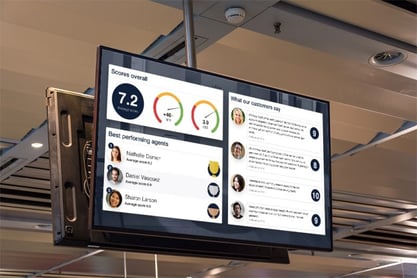
Customer experience is essential to take your organisation to the next level. Nowadays, there are many similar organisations on the market and you have to do your best to stand out. With an excellent customer experience, you do just that! You stay in the customer's memory and they are more likely to choose your brand.
In larger organisations, 1-2 people are in charge of the 'customer experience' piece. For example, a Customer Experience Manager, who researches how an organisation can optimise the customer experience. Yet this often remains within one department.
In practice, we see that it is difficult to get the whole organisation on board in the enthusiasm for customer experience. Making CX live within an entire organisation, truly building a customer-centric culture, is often a challenge. It is seen as a cost and the team is not engaged with new CX plans or results.
To make CX really live and become fully customer-centric, often the whole company culture has to be changed. This sounds like quite a step, but with the following tips, it is very gradual. Read how to take the first steps towards a customer-centric culture within your organisation in this article.
1.Create a clear CX vision
Set goals and communicate them to your team. Having a common goal works well because then you all go for it! It makes for better teamwork and a dot on the horizon you can stick to as an organisation. As a result, everyone will become more engaged and understand why decisions are made. To change the organisational culture as a whole, this needs to be encouraged from the top and reinforced by every level of management. You do this by repeating it structurally, making plans visible and giving rewards. You can read how to work with rewards later in this blog.
2.Spend time and effort in change
By getting your team, or key stakeholders, to help out and thus asking valuable time from them, you ensure that they are more engaged with the project. Make a time schedule and monitor whether everyone sticks to the deadlines. This way, you keep them involved and you can also keep good track of which plans have been implemented.
You will also need to set aside a budget to realise plans, an investment in improving the customer experience. Think better customer service programmes or a customer satisfaction survey. It is important for a management team or board of directors to understand where the money is going and what it will deliver. This will also make management more engaged because they want to know how high the ROI is. Communication is leading here, by continuing to communicate and understand where the investment is going, it will stay alive. So then it is up to the project manager, who takes on CX, to actually make this happen!
In addition, it is also important as management to show that you are not just talking, but doing! When they see that all the effort is paying off, they will understand why customer-centricity has so many advantages and you can move on to new innovations!
According to PWC, customers are willing to pay 16% more for an excellent customer experience
3.If you want to be good to your customers, be good to your team first
You've probably heard this statement before. It doesn't lie either! It's all about work happiness. If you are good to your employees, they will also be happier in the workplace. And happy employees are willing to work harder for you, and (un)consciously treat customers a lot better too.
Not sure how your employees are in the game yet? Or do you want to improve work happiness? Then take a look at Employee Experience. With this, you focus not only on the customer experience, but also on the experience of your employees. Read how to measure your employee satisfaction here.
Through this basically natural, no-cost approach, you will deliver a better customer experience to your customers.
4. Make it visible
Narrowcasting is the tool to increase visibility. It is a very good tool for bringing customer experience to life on the work floor.
Narrowcasting is a form of communication that reaches your employees in the office through screens with relevant information. On these screens, you can publish real-time feedback from your customers. This works very well in your customer service department, for example. Because they can see customer feedback on screens right away, they are encouraged to help the customer better. Of course, you don't want everyone to be able to see that the customer was not helped properly or that the problem was not solved. There is thus a healthy competitive struggle among employees!
 Narrowcasting on the work floor
Narrowcasting on the work floor

Discuss the best reviews and celebrate victories! A good example to really create a customer-centric culture is to share and celebrate victories. This can be small, like the most positive review what you share with your team, or a big win like 10,000 completed positive feedback. People love rewards and recognition, it gives more motivation and playful atmosphere in the workplace. So again, this hooks into what was mentioned earlier, being good to your employees.
5. Listen to ‘the Voice of the Customer’
Listen to what your customers have to say. This seems obvious but it is often forgotten or done too little. By structurally asking for feedback throughout the customer journey, you find out where the customer is happy and where there are negative experiences. This is very valuable information, because you can use this data to improve the customer experience at times when things are not going so well. Your team thus understands the pain points and are more motivated to solve them because the customer's problems become visible. You take a customer-oriented approach!
Turn customer feedback into personalised reports by department. That way customer service knows how they score, the marketing department gets insights into the online experience and management gets to be the overall customer satisfaction. A great way to make it live within your organisation!
Extra tip: Consider a key factor in 2020: Safety
Besides all the 'standard' adjustments to take customer experience to the next level, the global pandemic has added another important factor. Namely security. You only create an excellent customer experience that customers come back for when you put their safety first. Think for yourself, will you go back to a shop that did not take safety rules seriously? Where there were too many people inside and no clear walking routes? This does not inspire good trust and will turn customers away. So in the year 2020, make sure you have a foolproof safety plan for your customers. This includes enough space, a safe atmosphere, as much non-contact as possible and hand hygiene.
Own it!
Do you want to be known as the organisation that puts the customer first? Who listens to the customer? Then act like it. If you don't, you will quickly fall through the cracks. Changing your corporate culture requires energy and change, but it will pay off over time with loyal customers who will always choose your brand. Your turnover will thus be increased and your reputation will also be improved. Enough reason to go for it.
Do you want to measure how customers see your brand now? Or are you already working on customer experience and are you curious whether customer satisfaction has increased? Insocial's all-in-one feedback platform allows you to measure and analyse the entire customer journey.


